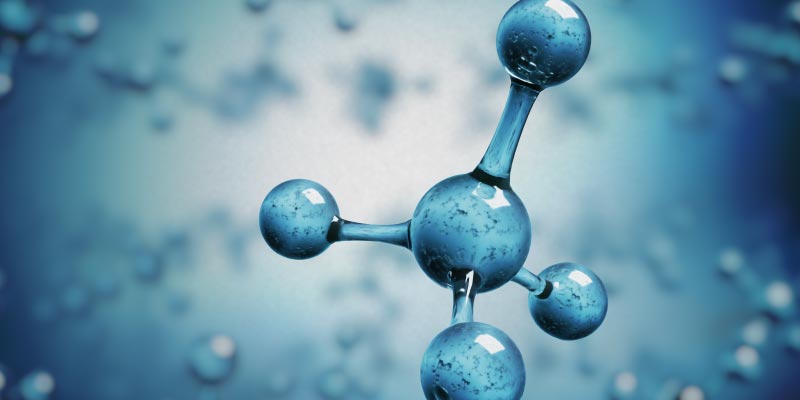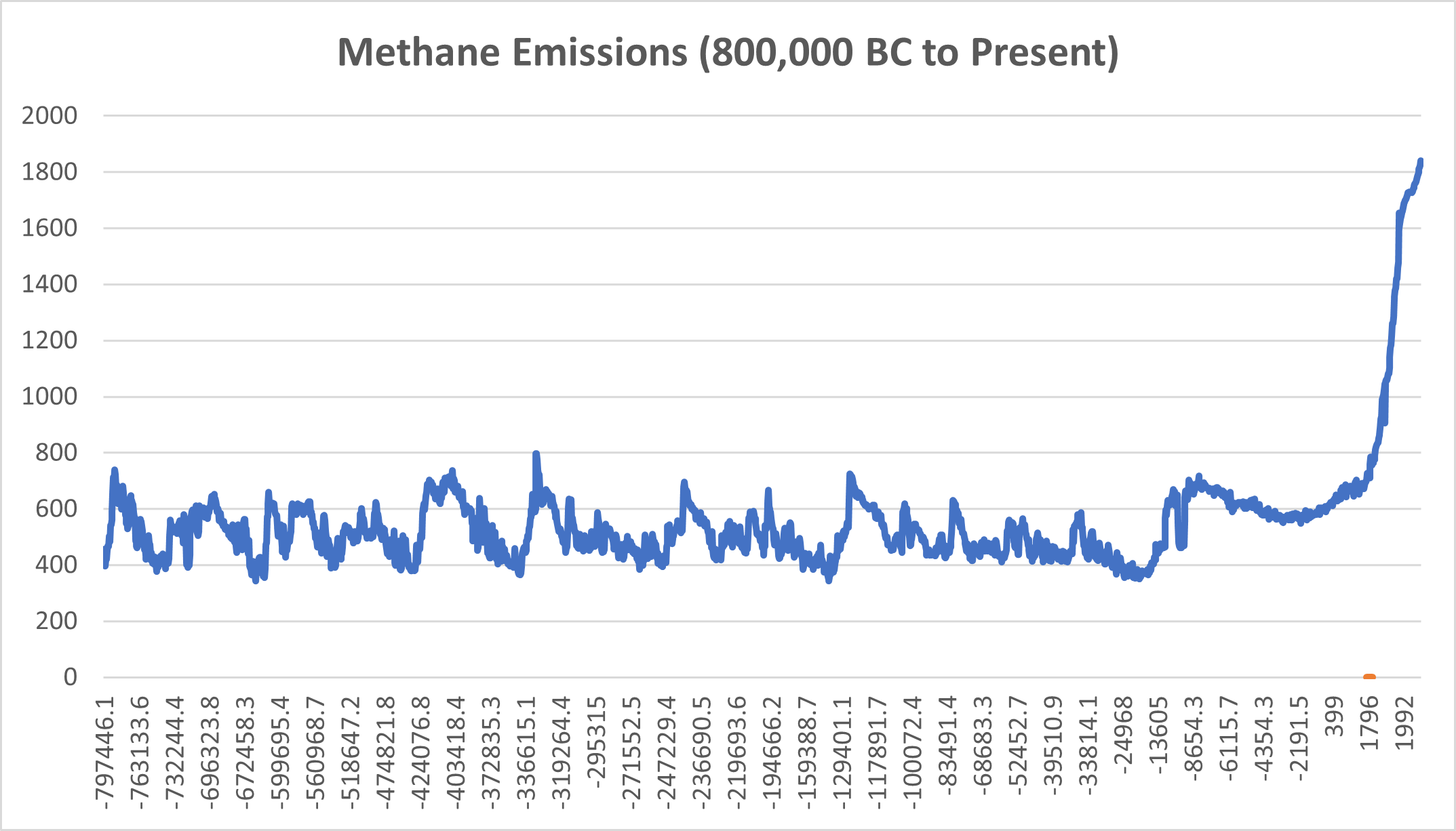Methane 101: Examining Its Massive Impact on Climate Change
May 16, 2023

When discussing climate change, the topic of methane emissions often arises. But what is methane, where does it come from, and how does it impact the environment?
What is methane?
Methane (CH4) is an odorless and colorless gas that is released into the atmosphere through a variety of human-induced and natural means. Once methane has entered the atmosphere, it is considered to be a greenhouse gas. As with other greenhouse gases—carbon dioxide, nitrous oxide, and fluorinated gases—the build-up of methane in the atmosphere traps heat and is a major contributor to climate change.
The good news is that methane gas has a much shorter lifespan in the atmosphere than carbon dioxide, lasting only 10 to 12 years before decomposing. By contrast, CO2 has a lifespan between 300 and 1,000 years according to NASA.
The problem? That “good news” isn’t all that good upon looking closer.
This is largely because methane traps heat at a much higher level than CO2. Greenhouse gases are assigned global warming potential (GWP) values for different time horizons, as a measure of their effectiveness at trapping heat in the atmosphere. Methane’s GWP is 27 to 30 times higher than CO2 over a hundred-year period according to the US EPA. Over a twenty-year period—a timeframe widely considered pivotal to combating the worst effects of climate change—methane’s GWP is 84 times that of CO2.
And although this fact is alarming, it does have a silver lining. Methane’s short lifespan means that if we focus on reducing worldwide methane emissions, we can have a practical, tangible, and near-term, positive effect on climate change.
Where do methane emissions come from?
Methane emissions come from a variety of sources, both natural and human-induced. However, the evidence shows that human-induced methane emissions are far greater than natural emissions. National Geographic reports that only 10% of annual methane emissions come from natural sources, the largest of which is wetland decomposition. The remaining 90% of emissions find their origins in human activity.
Evidence shows growing populations and industrialization over the past two centuries have super-charged global quantities of methane emissions.
According to the National Oceanic and Atmospheric Administration (NOAA), methane levels in the atmosphere currently average 1,895 parts per billion (ppb)—meaning, out of every billion molecules in the air, approximately 1,895 of them are methane.
While that may seem like a small amount at first glance, that’s more than three times the amount of methane that was present in the atmosphere from 800,000 BC to 1840—highlighting man’s role in the sudden and dramatic rise in emissions that trailed the industrial revolution.

Source: EPA's Climate Change Indicators in the United States (negative numbers represent BC)
After all, the shift from an agrarian and handicraft economy to one dominated by industry and machine manufacturing brought with it the mass production that both resulted from, and fed into, a rapidly expanding population. This strained methane-emitting industries, and in turn, drove their growth alongside that of society’s, satisfying market demands but exacerbating atmospheric pollution in the process—a cycle that has continued into the modern day.
A McKinsey report cites Agriculture as the leading offender of methane pollution, accounting for between 40 and 50% of total emissions. The Oil and Gas sector accounts for 20 to 25%, and Coal mining 10 to 15%.
According to a report by the California Air Resources Board , agriculture also sits at the top of the offender’s list, accounting for more than half of the state’s methane. At number two, however, is landfill waste, accounting for approximately 20% of those emissions.
Landfills present particularly thorny problems on many levels and methane emissions are just one of them. Aerial surveys of landfills in California conducted by NASA’s Jet Propulsion Laboratory and Scientific Aviation have found landfills leaking methane at six times the levels they report to the EPA. These so-called “super-emitters” release so much methane because organic materials, such as food waste, yard waste, and some post-consumer waste, are broken down by bacteria, generating methane and CO2 along the way. NPR reports that landfills are the third-largest source of methane.
Overall, methane emissions account for 16% of GHG emissions globally, says The Center for Climate and Energy Solutions . While methane trails far behind CO2 at 79%, it is far more effective at trapping the heat and radiation that causes global warming.
Geographically, the International Energy Agency says that the top 5 emitters of methane—China, India, the United States, Russia and Brazil—account for nearly half of all methane emissions.
How big is the methane emissions problem?
According to the Environmental Defense Fund, methane accounts for at least 25% of global warming and NASA reports that, although emissions slowed between 2000 and 2006, they have since resumed their steady upward clip.
Scientists have articulated that greenhouse gases are creating a feedback loop wherein the warming temperatures are triggering more natural methane emissions. They point to the molecular composition of methane. Methane that is industrially generated contains more carbon-13 isotopes than methane from natural sources. What has been observed since 2007 is that atmospheric methane actually contains fewer carbon-13 isotopes than previously measured, indicating the planet itself is contributing more and more of this warming gas to the total pool as time goes on.
Methane emissions in 2020 and 2021 showed the largest increase since monitoring began in 1983. Human-induced methane emissions have also grown during this time: agriculture-sourced methane emissions rose by 12% and fossil fuel-source methane emissions rose by 17% as of 2017.
The continued and unimpeded increase of total methane emissions due to these and other converging factors makes addressing human-induced sources even more urgent.
Does methane reduction have other benefits?
The shorter lifespan of methane, it’s huge impact on global warming, and the prevalence of human-induced methane emissions combine to make reducing methane emissions a practical endeavor with near-term, measurable results.
But, it also has very tangible economic outcomes.
According to the independent, non-partisan Council on Foreign Relations, every ton of methane reduction provides $4,300 in benefits. To put this in somewhat startling context, a 2018 report in Science, reports the U.S. oil and gas industry leaks 13 million tons of methane per year. While this represents only 2.3% of their total fuel output, this leaked methane is enough natural gas to fuel 10 million homes and represents $2 billion USD in potential revenue.
A similar report by the Environmental Defense Fund indicates a full 3.7% of all natural gas produced in the Permian Basin leaks into the atmosphere. This oil-and-gas-rich area in West Texas accounts for about 30% of all US oil production so this is a significant leakage that could be re-captured and turned into economic and social value.
The Climate and Clean Air Coalition, which advocates a 45% reduction in methane emissions by 2030 , notes additional benefits of such a reduction:
- Preventing 225,000 deaths from respiratory and cardiovascular diseases
- Avoiding 775,000 asthma-related hospital visits
- Saving 26 million tons of staple crops
Cumulatively, according to the Coalition, this will yield an economic benefit of $470 billion.
How can we effectively reduce methane?
The solution lies in a combination of forces that span our entire infrastructure. Just about everybody, in some capacity, can invest in cleaner, more efficient ways of doing things to reduce methane and other greenhouse gas pollution. That can be as simple as implementing more efficient appliances at home, to as complex as restructuring market supply chains into more closed-loop models. In the simplest of terms, it comes down to minimizing waste while maximizing resource value. And although it is simple, it is far from easy.
This can be accomplished across the board by concerting efforts in four key areas:
- Education
- Behaviors
- Technology
- Policies
Firstly, we need to change how we think and talk about methane and other greenhouse gases. Their causes and the gravity of their impacts need to be more readily discussed and fully understood if tangible, lasting progress is to be made.
Secondly, behaviors pertaining to production, consumption and disposal need to change. From a manufacturing standpoint, this can involve implementing stronger reuse and recycling programs and utilizing lifecycle analysis to design greener products that last longer, serve purposes beyond their standard use, and do not contribute to landfills and their host of problems.
Thirdly, technology needs to be utilized to its fullest. Energy markets need to shift to cleaner, more renewable systems. At the very least, legacy industries that rely on fossil fuels can invest in better equipment that generates and uses power more efficiently, leaks less and recaptures what does escape, leading to less waste and pollution. In a similar vein, waste markets must also be sustainably managed. Waste-to-energy, anaerobic digestion and composting are all great options for diverting waste from landfills, keeping its methane out of the atmosphere, generating carbon-negative energy in the process.
Lastly, come policies. Governments can push out more impactful environmental legislation and movements, such as Extended Producer Responsibility; give compliance penalties more teeth; and create incentive programs and rewards to inspire companies and communities to take their sustainability efforts and do more, do better, and do it cohesively.
What comes next?
Reducing methane emissions stands as a feasible goal with results that would make a marked difference in the vitality of the environment, the economy, and day-to-day well-being. But the work is not going to take care of itself.
Business leaders, governments, and consumers need to all do their part to ensure that methane emissions are reduced. It needs to be talked about more candidly, behaviors need to change, and technology and policies need to keep up to support and reinforce those changed behaviors.
But business leaders, especially those in high-emitting industries, need to take the initiative on this matter of methane. Whether it’s through recovering leaking natural gas wells or ensuring waste never reaches a landfill, they will be the difference-makers. If not, they will have the most to lose.
To learn more about methane and how you can reduce its impact while benefiting your own operations, download our zero waste-to-landfill eBook.